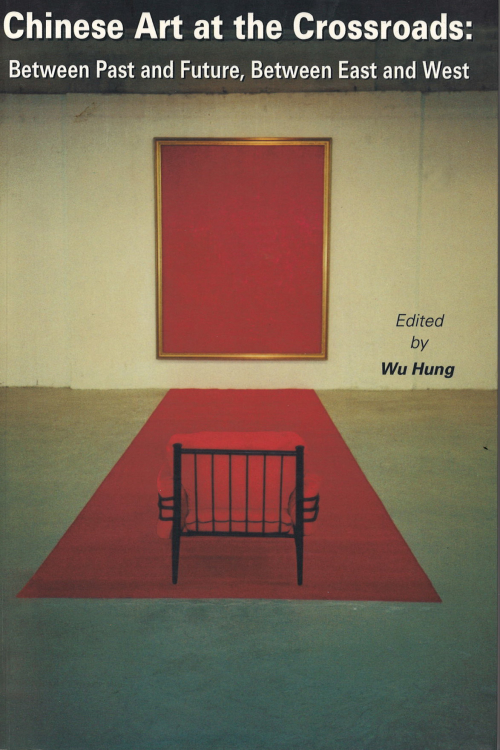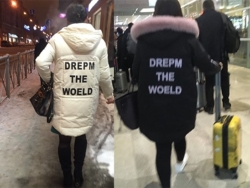I-Ying Liu, Stuart Hall Library volunteer explores the theme of identity in Chinese contemporary art.

Chinese Art at the Crossroads: Between Past and Future, Between East and West edited by Wu Hang. Available for purchase in shop
When asked to write about ten Chinese contemporary artists, the first thing that popped into my mind was a question: What is Chinese contemporary art? How is it defined? As someone who doesn’t regard herself as but is and ‘looks’ Chinese in some way, this task seems particularly tricky, but intriguing at the same time.
Previous artist-in-residence at Stuart Hall Library, Ting-Ting Cheng (鄭亭亭) continued her exploration of identity politics from her time at the Centre for Chinese Contemporary Art (CCFCA) in Manchester. The resultant work is a performance that restages ‘A New Vocabulary for Chinese Art?’, a seminar the institution organised in 1998. Setting out to rethink the term ‘Chinese’ in various cultural contexts, the seminar has raised questions of why people need this label and who it is for.
‘Is it for artists to identify themselves or for others to define them?’, asks Cheng. What does this self-identification suggest? Is it a mere compliance with the norm, an indication of cultural origin, a declaration of political stance or a manifestation of loyalty? And who are the ‘others’? Are they the audience looking to get a sense of certain artistic practices, governmental bodies to strengthen their diplomatic soft power, institutions to tick diversity boxes or markets to cater for collectors’ taste? Or according to art historian Wu Hung in Chinese Art at the Crossroads (2001), a book Iniva co-published as part of its international art series, is the very definition of this term constructed to be challenged and pluralised?
These are the questions that hovered over my mind while I was doing research for this blog post; they also exerted direct influence on my selection process, pushing me to question and examine my decisions. The guideline I set for myself is to look at emerging or mid-career artists that stand out and those who, regardless of nationality, offer critical comment on the contemporary Chinese societies and/or who rethink the very notion of ‘Chineseness’ in their practices. And of course, the list has been shaped by the collection at the Stuart Hall Library of Iniva, me and my friends’ knowledge of the art world; I acknowledge its unavoidable bias and omissions.
During my research, I came across the catalogue of the exhibition One Hand Clapping, which took place at the Guggenheim Museum in New York in 2018. The exhibition brings together artists to explore how globalisation shapes human understanding of the future. Among them includes Cao Fei (曹斐), one of the pioneers in Chinese video art. Cao has developed a unique language to visualise the drastic changes, such as accelerating economic growth, urbanisation and globalisation, that occurred in China in the past decades.
Through deadpan humour and surreal backdrops, her earlier works, including the renowned Whose Utopia (2006), examine the tension between the capitalist system and the labourers in China. Cao’s interest in subcultures like gaming and Japanese manga further leads to her exploration of virtual reality, as well as its interplay/disconnection with the actual world. One such example is her most recent film, Asia One (2018), which portrays an eerily deserted factory populated by robots.

Utopias edited by Richard Noble featured in Ting-Ting Cheng’s On the Desert Island
Featured in the Virtualities series of Iniva’s 2018 Research Network programme, Shanzhai Lyric is a body of research that looks into the global phenomenon of mass production and the agency of the nonsensical. After a field trip to Beijing in 2015, the founding members Ming Lin and Alexandra Tatarsky started an ever-growing collection of T-shirts with misspelled texts, mostly manufactured in China. Through researching, displaying, discussing, wearing and collectively reading from the counterfeit clothing, they activate both their physical and Instagram archives, proposing new ways to disrupt the incessant rhetoric of marketing and branding in the fashion industry.
Language has also been an integral part of Furen Dai’s practice. Her early years as a professional translator has prompted her to research how means of communication lose function, usage and history. Among all, she takes a special interest in Nüshu, an endangered language that derives from Chinese characters and is used exclusively by women. The Language-Producing Factory (2017) is the resultant work of her bittersweet visit to a village, where women are asked to perform Nüshu as an entertainment for tourists. By playing a video of them churning out texts inside a cage-shaped installation, Dai critiques how the patriarchal society continues its structural oppression by commodifying and profiting from a cultural product that was created as a resistance.
Living and working in Beijing, Hao Jingban (郝敬班) always draws inspiration from her surroundings, just as her long-running project that researches into the obscure Beijing Ballroom (2012-2016) community started from an occasional job opportunity to document a ballroom dancer’s birthday party. Juxtaposing and intercutting documentary footages with fictive scenes, she has worked to uncover an otherwise secluded world and elaborated on its transformation along with the upheaval of the Chinese society in the pre- and post-Cultural Revolution periods.
Having completed a PhD in Chemistry, Cheng Xinhao (程新皓) is a self-taught artist who works with photography, moving images and texts. Despite living in the metropolis of Beijing for over a decade, his attention has been on the Southwest province of Yunnan, where he was born and raised and which is undergoing rapid urban development. Through long-term field research on specific subjects, such as a river, a village or an ethnic group, Chen investigates how political forces and value systems in different historical times have converged, contradicted and together shaped the present of his hometown.
Well versed with both classical music and contemporary sound art, Sampson Young (楊嘉輝) interweaves multiple narratives and references to probe the possibility of sound and its cultural politics. Also featured in the abovementioned exhibition of One Hand Clapping, Young’s practice concern universal topics ranging from military clashes, borders, migration to identity, while his native Hong Kong persists as one of the major subjects, if not the core, of his research. The city’s transition as a result of China’s rule and the consequent tension between the two political entities have driven him to collect ambient sounds from historical sites as well as quotidian spaces, and remix them to produce works such as Liquid Borders (2012-14) in response.
Sexually explicit content, enacted by cartoon characters, pervade Wong Ping’s (黃炳) psychedelically coloured animations and installations. Running through his erotic visual language is the notion of control and limitation. In some works, such as Jungle of Desire (2015), Wong confronts the repressed and inexpressible desires of human beings; in other cases, they smuggle pointed political messages. Developing the newly commissioned Heart Digger (2019) in London along with the heated Anti-Extradition protest in his home city Hong Kong, the artist created, for his heart-shaped grave installation, a fable about a self-detroyable escape tunnel dug by Hong Kong’s officials. Through this work, he offers critical comment on the three-way relationship between the city and its former colonial and current ruling powers.

A View from elsewhere, One Hand clapping and Chinese Art at the Crossroads
In the forms of performance, video and installation, Chen Tianzhuo’s (陳天灼) works sit on the border of an orgy-like party and a ritual site. He draws inspiration from disparate elements found in pop cultures (cartoons, hip hop), subcultures (cult, drag and rave), dance (Japanese Butoh and Voguing) as well as religions (mainly Buddhism) before twisting and re-clustering the symbologies of these systems in his self-made props, costumes and flashing lights. Just as writer and editor Sam Gaskin comments in his interview with Chen in the magazine Ocula Conversations (2016), ‘In a way it’s radical for Chinese contemporary art, where humor is more often biting than absurdist. Chen is more interested in having a good time’.
Toronto born and London based, Victoria Sin works across performance, moving image, writing and print. Within these mediums, they focus on cultivating speculative narratives surrounding desire, identification and objectification, using drag as the predominant means of engagement. Drawing closely from their personal experience, Sin’s works often touch upon their mix-race family. The artist’s deliberate reference to their Asian/Chinese background in several works, with If I had the words to tell you we wouldn’t be here now (2019) as an example, displaces the ultra-whiteness of their drag character while casting light on the predominantly marginalised and invisible.
With its title borrowed from Victoria Sin’s eponymous book (2018), this blog post intends to challenge the public’s normative perception of ‘Chinese art’ and sketch out an alternative path to the contemporary artists who themselves or whose works relate to China or Chinese to various degrees and in various ways. It is hoped that the discussion above can move the term away from a label that evokes a narrow, nationalist imagination or cultural stereotypes, and instead open up its possibility to operate as a prism that refracts not only specific social issues but also broader human experiences.
Biography
I-Ying Liu is a recent graduate of MFA Curating at Goldsmiths, University of London and works on independent curatorial projects. She has research interests in migration, identity politics, language and translation.
Bibliography
- Dickie, A. & Bailey S. (ed.) (2016) Ocula Conversations, Ocula. (Chen Tianzhuo included)
- Hou, H. (2017). ‘Cao Fei’s avatars and antiheroes’, Parkett, Vol. 99, pp.36-45.
- Hou, H. (2005). ‘Cao Fei: a mini-manifesto of new new human beings’, Flash Art International, No.242, pp.126-127.
- Hou, H. & Weng, X (2018). One Hand Clapping, Guggenheim Museum. (Cao Fei, Wong Ping and Sampson Young included)
- The Shanzhai Lyric (2018). ‘Reflect are u ready 4’, Art Review Asia, v.6, no.1, pp.74-79
- Obrist, H. (2006) ‘Cao Fei’, Artforum International, Issue XLIV, No. 5, pp.180-181.
- Sin, V. (2018). A View from Elsewhere, PSS/ PS/Y for Hysteria.
- Stooke, A. (2017). ‘Shanghai Biennale: Why not again – arguments, couter-arguments and stories’, Art Monthly, 403. (Hao Jingban included)
- Stuart Hall Library (2018) ‘ Launch: On The Desert Island Ting-Ting Cheng and Stephanie Moran’.
- Stuart Hall Library (2018). ‘The Shanzhai Lyric: An Interview with Ming Lin and Alexandra Tatarsky
- Wu, H. (2001) Chinese art at the crossroads: between past and future, between East and West, New Art Media and Iniva.
